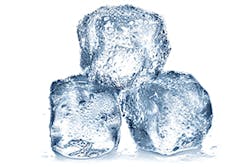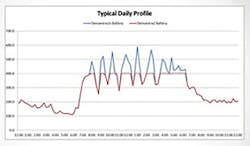For buildings that experience high energy consumption, Ice Thermal Energy Storage is a complimentary chiller add-on that is proven to reduce operating costs by creating and storing cooling the night before. This ice add-on, along with new battery technology, dramatically reduces peak demand and the strain on the grid. However, lack of understanding around the implications of air conditioning loads on the grid and utility rates mean most engineers and equipment owners head straight for the conventional chiller-based air conditioning systems to create instantaneous cooling.
What You Really Need to Know About Air Conditioning
It’s winter and, if you’re like me, you’re already looking forward to summer when you can get together and enjoy the nice weather outdoors in backyards with friends, filling your cooler with food and refreshments and lighting up the grill. You would never think of neglecting refreshments at one of these barbeques or forgetting to provide refreshing ice-cold beverages. Which is why you would never start making ice as people began walking through the door, right? That would be ludicrous.
Yet that analogy is similar to what is occurring every day in our buildings, only 100 times worse. We design the HVAC system so large that it can instantaneously provide enough cooling for a full load of people during a heat wave. There is no planning or optimizing involved other than designing, purchasing, installing, operating, and maintaining a cooling system to handle the biggest cooling load on the hottest day. How often does that situation happen? It’s as if no one knows the grid is changing. Owners install, finance, and maintain a too-big-to-fail cooling system.
For parties, about a pound or two of ice per person is needed. Keeping that same person cool the next day in a building requires the equivalent of energy to make 150 to 300 pounds of ice. Think of the time, energy, resources, and money wasted by not optimizing your building’s needs daily.
If we plan ahead for our barbecues, wouldn’t it make sense to plan ahead to cool our buildings, too? Planning ahead just takes a little foresight and a special key ingredient—thermal energy storage. Thermal energy storage stores ice to cool people in buildings. It’s a novel approach to conventional air conditioning, akin to making ice before the party.
So why isn’t this ice storage cooling standard practice in buildings, especially when energy costs two to three times more during the day than at night? Part of the problem is that people don’t like change and many energy consumers just don’t understand their electricity bill and the role that peak demand charges play in hiking up energy prices. Those that do know are outperforming their competitors in energy costs savings.
Do the math: First, some assumptions. The average person working in a typical office building is given 100 square feet of space. A typical office building needs 1 ton of cooling for each 400 square feet. That’s 1/4 of a ton per person.
100 feet2/pp/400 feet2/ton = 0.25 ton/pp.
Assuming that person works 8 hours means that person requires 2 ton-hours of cooling.
0.25 ton/pp x 8 hours = 2 ton-hours/pp.
To figure out the pounds in one ton-hour, take 12,000 BTUs/hour (the equivalent to 1 ton) and divide that by the latent heat of ice (144 BTUs/pound).
That’s 83.3 pound/ice.
12,000 BTUs/ton-hour/144 BTUs/pound = 83.3 pound/ice.
Therefore, 2 ton-hours would be 166 pounds and 5 ton-hours would be 416 pounds. If you use the high end of the ranges (200 feet2/ton and work for 10 hours) you can assume 5 ton-hours or 416 pounds per person.
83.3 pounds/ice * 2 ton-hours = 166/pounds. 83.3 pounds/ice * 5 ton-hours = 416/pounds.
That’s a lot of cooling needlessly being created when prices are high and the consequences on utility bills and the grid are huge.
Cooling’s Huge Consequences
One need only look at utility load factors to truly understand the huge implications of instantaneous creation of cooling. Load factor is a ratio of average load to peak load. A good load factor of 100 is like having a lightbulb on for 24 hours, like an EXIT sign, for example. However, society doesn’t use energy at a steady rate both day and night.
One-fifth of power generation is needed to meet less than 2% of hours in the year. 40% of summertime peak is the instantaneous creation of cooling. Since air conditioning is the leading culprit behind peak energy demand, reducing air conditioning use during summer peak periods can greatly improve problems with the grid and associated utility costs.
Cooling’s Big Cost
To help compensate for increased power infrastructure, utilities charge commercial energy users hefty demand charges. Demand charges are calculated based on the highest rate of electrical use, which happens during a 15- or 30-minute period during the billing month. Demand charges can be up to 70% of commercial customers’ utility bills, whereas air conditioning can add up to 40% of a building’s peak electricity usage.
To reduce peak electrical use, thermal energy storage systems use standard chiller equipment plus an energy storage tank to shift all or a portion of a building’s cooling needs to nighttime hours. At night, some utilities offer lower Time of Use rates. Other utilities charge a flat or blended rate, which incorporates demand charges into a simple average. These rates make it appear that the customers are being charged similar rates both day and night. This is usually not the case. Better flat rates may be negotiated by reducing peak demand.
Do the math: To understand the effect of demand charges on the utility bill, consider this example of a 1,000-ton system (approximately 500,000 square feet of air conditioned space). There is a flat rate of 8.5 cents per kWh for both day and night energy use and a $14 per kW per month demand charge. The math works out so that the daytime energy cost is actually double the nighttime rate.
Do a back-of-the-envelope calculation to:
- Understand the demand contribution to the energy consumption charge;
- Compare the true costs of daytime and nighttime power by taking the demand charge (kW) and converting it to energy usage (kWh). Calculate how much cooling is used at the building, the number of hours and days the building operates, and the diversity factor (typically 75%).
2) Calculate the Energy Consumption/Month by calculating how often the chiller is used in a given month during the day. This example assumes 10 hours with 75% diversity and 22 days.
1,000 tons * 10 hours * 75% (diversity) * 1.0kW/ton * 22 days per month = 165,000kWh/month.
3) Convert cost for Demand Cost/month to kWh by dividing the daytime demand costs/month by energy consumption/month. The result is the daytime additional demand cost in kWh for cooling.
$14,000/month divided by 165,000kWh/month = $0.085/kWh.
Next, add the flat rate energy charge (kWh) to the demand cost (kWh). Your true daytime cost is 17 cents.
$0.085/kWh + $0.085/kWh = $0.170/kWh.
Part 2. Compare costs of daytime and nighttime power.
The building peaks during the day, so the nighttime demand charge is zero and the energy charge is the flat rate of $0.085/kWh. To summarize this, during the night, the energy cost will be 8.5 cents per kWh, while during the day a kWh costs 17 cents. Buildings that do not avoid daytime peak energy consumption pay 50% more for cooling. Since cooling makes up a massive amount of the building’s electric load, this extra cost plays a big part in overall operating expenses. Thermal energy storage helps by shifting the massive cooling load to nighttime. However, storing energy is not just as simple as shifting loads.
Beyond Thermal Energy Storage
If you zoom in more closely to a building’s electricity load profile, you’ll see that the Cooling Load is jagged.
Batteries help with this unevenness because they can charge and recharge throughout the cooling cycle. This jagged characteristic also creates a smaller diversity factor, which results in the following:
- Fewer batteries being required for kW reduction (Instead of six batteries staying in discharge mode during the cooling cycle, three batteries can take turns charging and discharging during the cooling cycle.)
- Fast discharge (Batteries are suited for charging quickly to meet the next spike.)
In contrast, thermal energy storage is typically used for longer durations and typically has 4- to 8-hour discharge cycles during the day.
Therefore, to optimize the peak load reduction, first deal with shifting the massive cooling load. Reduce 20–40% of the peak load with thermal energy storage. Then, smooth out the jaggedness of the reduced peak load with batteries. In this way, batteries work synergistically with ice as a total energy storage solution.
Batteries and Ice Together
Batteries are similar to thermal storage in that they can both store the same demand capacity over the same period of time. For example, both a six-battery (18kWh) system or one ice tank can store 18kW over 6 hours to cool 7,500 square feet. That’s 108kWh/day per system.
However, installed costs are not the same. Ice is an add-on to a conventional cooling system. By itself, the installed cost of 108kWh of ice is approximately $22,000. However, in most new systems when ice is added, the chiller capacity is reduced and offset with ice, making the cost for adding 108kWh of ice just $7,000. The kWh equivalent cost for batteries is $100,000.
That’s a big difference. However, remember the jaggedness of the load? By discharging quickly, half the batteries can be used, slashing the installed price down to $50,000. Still, the batteries’ price is higher than the $7,000 ice add-on for the same 108kWh.
In a more realistic example of a large commercial building, reducing 360kW with ice would add $140,000. With batteries, you’re paying a million.
Are the batteries worth it? Absolutely. Batteries address the electrical loads of the building which ice cannot. Batteries can power anything, take up less space per unit energy than thermal storage, and can be used for backup power and ancillary services, including synchronous reserves to keep the grid in check.
Both batteries and ice have their advantages, but ice reduces demand at a fraction of the costs. Ice tanks have a lifetime of approximately 2 to 4 times as long as batteries, are proven in thousands of installations, are 99% recyclable, and can be used for demand response or synchronous reserves (load reduction).
In addition, ice systems store cooling which is tremendously importantly with implications for the grid and utility bill. It wouldn’t make any sense to use a battery’s stored energy to run a compressor and create instantaneous creation of cooling. Instead, store the energy in the form in which it will be used. Combining ice and a battery to address a given peak demand reduces the costs by 75% compared to a battery alone.
A new cooling system is an important investment with far-reaching consequences. Why continue doing things the ways they’ve always been done? The Grid will be going through radical changes in the coming decades, so it makes sense to install a system that has the ability to adapt to any change.




